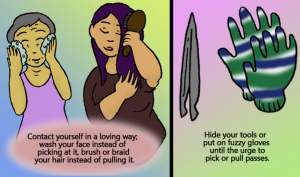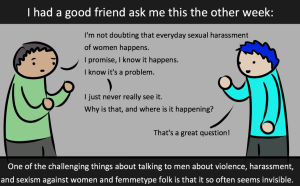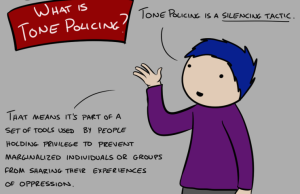First of all, if you’re related to me, proceed with care, because it’s about to get real personal in here.
As I’ve written about before, it took me a while to become sexually active. And when I did, I thought for a long time that I had some kind of sexual dysfunction.
I enjoyed my sexual experiences, both solo and partnered, but I never had the kind of orgasm I saw in movies, porn, and even my female partners – the whole-body, wild ecstasy, consumed-with-pleasure moment that seemed to be the standard.
I was pretty sure I was having orgasms; they were just a lot more low-key. I figured I had to do more growing, get more in touch with my body, and someday, I’d achieve the ideal orgasm. In the meantime, I spent a lot of time feeling envious and inadequate next to people who had a sexual response that looked more “normal” to me.
Then I went to grad school.
And there, in a program dedicated to Human Sexuality Studies, I found out that there are three different orgasm patterns that Masters and Johnson identified in cis women.
(They didn’t study trans and non-binary people, which is a pretty big limitation of their work.)
And I recognized my pattern immediately: It’s the second one in the diagram, the one with lots of little waves instead of a big peak.
I was blown away.
I had done a lot of independent reading about sexuality before going to school, and still, I was over halfway through my Master’s program before finding out that the way I orgasm is totally normal!
Let’s take a closer look at these three patterns of orgasm.
The first one is the one we see most often in media. For these folks, arousal increases until they hit plateau, a state of high sexual arousal that can be fairly brief or last a long time. Eventually, it peaks into a sharp, intense orgasm. After that, they may stay at plateau and have a second or even third orgasm, or they may drop off right away into resolution, the stage of happy exhaustion and relaxation.
The second is what I’m calling the mini-orgasmic pattern. People like me who have this pattern will either say that they don’t have orgasms, or that they have ten, twenty, or more orgasms in a single sexual encounter. The plateau phase has a lot of little peaks that never (or almost never) reach the intensity of the single or multiple orgasm pattern.
The third pattern is a faster and sharper rise. There’s no noticeable plateau phase; arousal just rises higher and higher until the intense peak, and then resolution. People who have this pattern often prefer shorter sexual encounters than people with the first two.
All three of these patterns are fine. They’re perfectly normal variations on how the human body experiences sexual pleasure.
Some people can experience more than one of them, and some people only ever have one.
But even realizing that I was completely normal, it took some time to get over the feeling that I was somehow inferior sexually. And the outside world didn’t help. I talked to a man once who insisted that women who don’t have loud, body-consuming orgasms just haven’t embraced their inner goddess.
And then, in response to a teenager writing on an Internet forum about her mini-orgasmic pattern, someone responded, “You’re still young – there are lots of hot, screaming orgasms in your future.”
That person, as well as Inner Goddess Guy, were trying to be positive and affirming – but what they’re really saying is, “The way your body naturally functions isn’t good enough. You need to keep trying to achieve the kinds of orgasms we see in porn.”
This is a feminist issue – one that affects people of any a/gender who have this orgasm pattern.
It’s yet another way the world tells us that our bodies aren’t enough, that they have to behave a certain way, and if they don’t, there’s something wrong with us.
I won’t lie: Sometimes, I still feel envious and inadequate. But there are some awesome things about the way my body responds sexually. And, as a person and a feminist, I want to celebrate the things I love about the way my body works – and cheer you on when you do the same!
So here are six things I love about being mini-orgasmic. Maybe you can relate to some of them, or maybe you’ll be inspired to come up with your own list of great things about the way your body works!
1. It’s Easier to Get There
I’ve had friends and lovers who take a lot of time and stimulation to get off. It’s always worth it, but just like I sometimes envy the intensity in their orgasms, they sometimes envy how quickly I can get there.
If my partner is at all invested in helping me get off, it’s usually going to happen at least a couple of times. (And if they’re not, that’s the last time I’m getting naked with them!)
Even a pretty quick sexual encounter usually leaves me feeling satisfied. Although it doesn’t have to be quick, because…
2. I Can Go On Forever
If I had to pick a favorite thing about being mini-orgasmic, this would be it.
If I’m in a good place mentally and physically, I can hit that peak level and hang out there as long as I and my partner are having fun, rolling out spasm after spasm of pleasure.
And the longer we go, generally the more sensitive I get, so after a really great marathon session, I’m left as gasping and limp as if I just had one of those “hot, screaming” orgasms from the movies.
I’m always a person who likes to savor the good things. I’ll eat a chocolate cake as slowly as possible. So I love having a body that can spend as much time as I want in the peak of sexual pleasure.
3. I Can Be Quiet If I Want To
I’m all in favor of loud sex, as long as you’re not waking your neighbors or staying at your grandma’s. Shout your pleasure to the skies!
But sometimes you are staying at grandma’s – or somewhere else where you want to keep things low-volume. I’ve lived with and dated people who have a hard time with that: either they just can’t keep it quiet, or they have to focus so much on controlling their noise that it detracts from the pleasure.
I can make plenty of noise if the environment allows for it, but I can also have a fully satisfying sexual encounter without making a peep (okay, maybe a peep).
Which means I have lots more options on where and when to have sex.
4. I Feel Like I Have Control
I’ll be honest: I’m a little bit of a control freak.
I don’t need to manage anybody else, but I get really anxious at the idea of my self-expression getting out of control. Especially with a new partner, I can only imagine that I’d have a hard time letting go if my orgasms were the kind that take over my whole body.
Whenever I talk about this aspect of things, someone is likely to pipe up and say, “Well, maybe if you could let go of control, you’d have those screaming orgasms.”
Whether that’s true or not, I don’t appreciate the attempt to reduce the way my body works to a psychological problem.
My sexual functioning is not here to prove how evolved I am as a person. It’s an intimate part of my relationship with my body, and I don’t need outside people telling me that it doesn’t measure up to their standard.
5. I Appreciate Many Different Kinds and Levels of Pleasure
Without a single orgasm as the peak of my sexual encounters, I’ve become very tuned-in to the different ways I experience pleasure. Those little mini-waves in the diagram don’t all feel the same, even if they look similarly on the chart.
It’s like reading a collection of short stories instead of a novel: lots of different, encapsulated experiences, with different moods. And I could stop with satisfaction after any of them, or I can keep going and experience something different.
I think we would all have better sex if we paid attention to the different levels of pleasure that come before and after orgasm!
Every stage of the journey can be pleasant in its own way, even if your body orgasms in the conventional one-peak way.
Because the destination isn’t as obvious for me, I learned very early to appreciate the whole journey.
***
One of the biggest gifts feminism has given me is teaching me to focus more on appreciating myself as I am, not comparing myself to images of people in media. That’s just as true for sexual response as for physical appearance.
As a sex educator, I see way too much writing about sex that’s along the lines of “5 Different Kinds of Orgasm Every Woman Should Have Before She Dies!” It’s great to write about diverse sexual experiences, but I hate how we make it a standard that everybody should strive for the same kinds of sexual pleasure.
Let’s, instead, work on celebrating the way our own unique bodies respond sexually, and loving what’s wonderful about them.
[do_widget id=’text-101′]
Ginny Brown is a Contributing Writer for Everyday Feminism, as well as a speaker and educator specializing in sexuality and relationships. She writes for various publications and has her own blog here. She lives in the Philadelphia area with her poly family and three cats. Follow her on Twitter @lirelyn.
Search our 3000+ articles!
Read our articles about:
Our online racial justice training
Used by hundreds of universities, non-profits, and businesses.
Click to learn more
Most Read Articles
- « Previous
- 1
- …
- 30
- 31
- 32




















